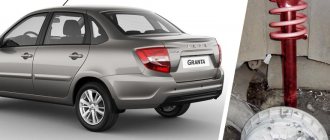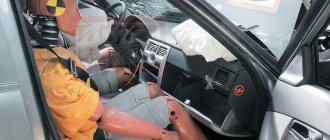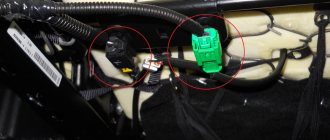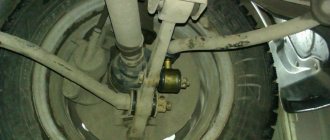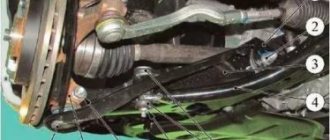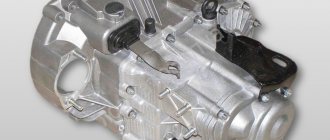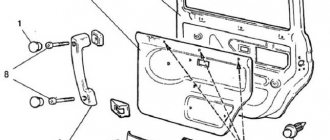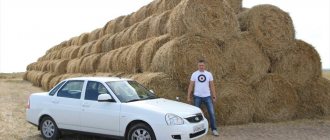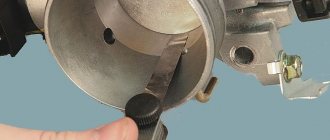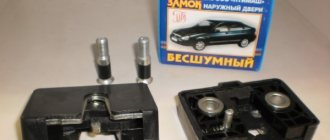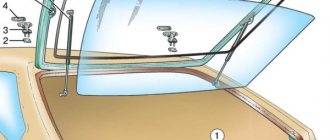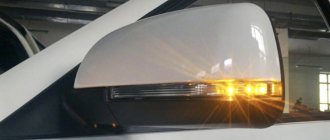Owners of domestic cars, and in particular the VAZ 2170, often resort to suspension tuning, improving the appearance and handling of the car. You can lower the suspension in various ways, which differ both in cost and in the complexity of the work performed. Therefore, before you begin such modifications, you should understand what you want to achieve and how much money you are willing to invest.
- How to properly lower the Priora
Air suspension - Suspension with adjustable ground clearance
- Lowered suspension
Video: replacing the front struts on a Priora
- Video: budget lowering of the Priora suspension
Pros and cons of a white car
Advantages of painting a Priora white hatchback car:
• Of course, a chic appearance! White color can visually increase volume. Therefore, clean and sparkling in the sun, as if from a picture, the white Priora hatchback always has an impressive and at the same time elegant appearance.
• In dry weather, dust and dirt are much less visible on it than on cars with a dark color. Pollution becomes noticeable only from a close distance, but from a distance the car appears clean. Accordingly, cleaning costs are reduced.
• White color tends to reflect sunlight. This is especially felt in the summer heat. The white Priora hatchback (photo below) heats up much less.
• It is clearly visible on the road, including at night. This most likely determines the statistics of accidents - white cars get into them much less often.
• The purer the white color of your Lada, the less susceptible it will be to fading. In case of repairs and the need for touch-up, it will be much easier to choose a shade that best matches the original one.
• Small scratches and chips are much less noticeable. This is because paint primer is usually white. Therefore, if the scratch is shallow, then it is not visible.
• White Priora hatchback lends itself very well to modernization. Tuning (pictured), which will make your car original, can be done with your own hands.
Choosing racks for Priora: the main differences between modern products
Domestic and foreign manufacturers offer high-quality parts. Standardly installed on the SAAZ oil type product model. Their approximate price is 1800-2000 rubles. They are optimal for driving in urban areas and on minor off-road conditions, and cope well with long journeys along the highway. Travel on uneven surfaces is well tolerated for the first 30-40 thousand km, and then they may require replacement.
The Japanese Kayaba racks have also proven themselves positively. The company has recently appeared on the domestic market, but has pleased customers with both a reasonable price and good quality: the elements cope with both off-road driving and highway racing. They have good stability and are able to absorb strong shocks.
When purchasing products, it is important to study the certificate, since there are also low-quality fakes on the market. A novice motorist who is determining which struts are best for a Priora will definitely like the Japanese elements: they are easy to use and install
Domestic Demfi racks are highly durable and reliable. The service life with careful and careful driving can be more than 70 thousand km. The cost of the products is low and every Priora owner can afford to purchase the parts.
It is important to focus on modern motorists who are accustomed to using personal transport for both work and leisure.
Therefore, when choosing which racks to install on a Priora for long-term use, you should pay attention to Demfi products
You can roughly determine which racks on the Priora are better, and which of them will last longer, based on the degree of rigidity of the products.
For example, SS 20 products differ in the degree of shock and vibration absorption. But the buyer needs to remember that rigid elements, completely eliminating roll in corners, will not provide sufficient comfort when driving on uneven road surfaces. Soft types, while guaranteeing ease of control, will not hold the road so well when passing sharp turns and spiral roads.
When studying suitable racks, you should not be guided by price. Cost will not indicate high or low quality. It is set according to the market segment, company rating, and delivery price. Therefore, custom-made products are usually more expensive than domestic analogues.
Flaws
• The white Priora hatchback (photo below) is difficult to see in heavy snow and fog, as it blends in with the environment. In this case, good side lights and driving in compliance with all traffic rules can help.
• In wet and dirty weather it gets dirty quickly, just like cars of any other color. However, on a white car, dirt is clearly visible and striking. Therefore, in the autumn-spring slushy season you will have to wash it more often.
• Drops of bitumen that will inevitably fall on the lower part of the body if you drive along a newly repaired road are best wiped off as quickly as possible. A slight delay and the rye-colored spots will remain on the surface of the Priora hatchback white car forever.
Description of design
Rear suspension elements: 1 — beam; 2 — anti-roll bar; 3 — silent block; 4 — bracket for attaching the lever to the body; 5 - trailing arm of the beam; 6 — brake drum; 7 — shock absorber; 8 — bracket for attaching the shock absorber to the lever; 9 - spring; 10 — shock absorber cover; 11 — spring gasket; 12 — compression stroke buffer; 13 — rear wheel hub; 14 - rear wheel brake mechanism Rear suspension - semi-independent, with an elastic beam, with helical coil springs and double-acting hydraulic telescopic shock absorbers. The longitudinal arms are welded to the beam through reinforcements. To increase lateral stability and reduce vehicle roll, a stabilizer bar made of 14 mm steel rod runs inside the beam. The ends of the rod are welded to the levers.
Rear suspension: 1 — rear suspension beam; 2 — shock absorber; 3 - spring; 4 — bracket for fastening the beam arm to the body
A rubber cushion is installed in the middle part of the stabilizer bar. Bushings are welded to the arms in front, into which silent blocks are pressed. At the rear, brackets with eyes for attaching shock absorbers and flanges for attaching the axles (axles) of the rear wheels and brake shields are welded to the suspension arms. The elastic elements of the suspension are coil springs. The lower coil of the spring rests on a cup welded to the shock absorber reservoir, and the upper coil, through a rubber gasket, rests on a support welded from the inside to the wheel arch. Bolt 1 passes through the inner race of the silent block, connecting the lever to the body bracket. The bracket is attached to the welded studs of the body with three nuts. 2In the lower eye of the shock absorber, a rubber-metal hinge (silent block) is pressed into place, through the central bushing of which a bolt passes, securing the shock absorber to the suspension arm bracket. The shock absorber rod is attached to the body through two rubber pads (one at the bottom of the support, the other at the top) and a support washer (under the nut). The chrome-plated surface of the rod is protected from dirt by a rubber corrugated cover, inside of which a compression stroke buffer is installed. A cylindrical collar made on the axle is designed to center it in the hole of the lever flange and center the brake shield on the axle. An unregulated double-row tapered roller bearing is installed in the hub. During operation, the bearing does not require replenishment of lubricant. The outer bearing ring is pressed into the hub and secured with a retaining ring. The fit of the inner rings of the bearing on the journal is transitional (with a slight interference fit or a small gap). The inner rings of the bearing are tightened in the axial direction with a nut, tightened with a large torque and secured by indenting the nut flange into the groove of the journal.
Shock absorber parts and spring: 1 - shock absorber; 2 - spring; 3 — compression stroke buffer; 4 — rod cushions; 5 — spacer sleeve; 6 — support washer; 7 - spring washer; 8 - nut; 9 — cover; 10 - cover cup; 11 — spring gasket
Rear wheel bearing assembly: 1 - axle; 2 - hub; 3 - bearing; 4 - retaining ring; 5 — washer; 6 — bearing nut; 7 — sealing ring of the hub cap; 8 — hub cap The angles of the rear wheels are set structurally by the geometry of the beam and are not subject to adjustment in operation. The angles can only be checked on a special stand and compared with control values (camber angle - 0°30'±30', wheel toe - 0°10'±5'). If the rear wheel alignment angles do not correspond to the control values, it is necessary to check the condition of the rear suspension elements.
Tuning
As shown in the photo, the white Lada Priora hatchback is one of the cars that most successfully accepts the modernization of its appearance. Even a simple replacement of standard bumpers with restyled ones and tinting the windows gives the car individuality. However, the fantasies of car owners do not end there.
• Various types of body kits are used in the color of the Priora (pictured) hatchback white. Tuning bumpers and radiator grilles, installing a spoiler sometimes make a car completely unrecognizable, aggressive and impressive.
• Photo of a white Priora hatchback, tuning it in a retro style, can often be seen on the streets. Chrome-plated hubcaps in the style of the 50s of the last century and white rims on the wheels leave no one indifferent.
• The Lada Priora hatchback (pictured) is white, with red lighting at the bottom and looks very original.
• High-quality LEDs and eyelashes installed on a white Priora hatchback (photo below) will make the headlight tuning complete and the appearance seamless.
Technical characteristics of Priora NFR
In fact, the new product should be a deeply redesigned European Peugeot 508 of the current generation. Priora NFR will retain the power structure of the prototype body and a significant part of the hinged panels. The front fenders, headlights, radiator grille, hood and bumper should be new. The car will retain frameless side doors. This will allow the exterior design to be brought to the corporate VAZ “X-style”.
In the manufacture of the car, high-strength steel grades will be used en masse, which will provide the body with high rigidity combined with low weight. This will make the car safe and economical. The prototype of the model, the Peugeot 508, scored the maximum five points in the Euro NCAP safety rating.
In terms of handling, the Priora should also not be inferior to its competitors. The car will receive an independent front suspension. At the rear, depending on the version, there is a torsion beam or a multi-link design. The rear beam will be equipped with diesel modifications intended primarily for taxis. The lack of a complex multi-lever in simple versions should not be a problem. The French have long been famous for their ability to correctly configure even the simplest suspension, squeezing the maximum out of it. At AvtoVAZ, it is worth noting, they are not inferior to them. Tolyatti engineers endowed Vesta with an excellent combination of comfort and handling with a fairly high ground clearance. Obviously, there should be no problems adapting the vehicle’s chassis to Russian operating conditions. Priora NFR will be equipped with wheels with disc diameter
Sport car
Very often, cars of the VAZ family are chosen as racing cars, especially for amateur competitions. One of the most suitable for these purposes is the white Priora hatchback. Pictures of sponsors advertising, riders' names and serial numbers are visible from afar on a white background.
Even the basic version of the car, the white Priora hatchback, features a sporty look. Tuning (photo below) will give it an aggressive and brutal look. Of course, a lot of work is required to upgrade the standard equipment to the racing version. But, as shown in the photo, the white Priora hatchback allows you to do it even in a garage, especially since there are no problems with purchasing components and spare parts for the Lada.
LADA Priora is one of the most expensive and at the same time best-selling domestic cars. Local car enthusiasts prefer the Priora because it is considered a car that has stood the test of time. But deciding on a car brand is only half the battle. It is clear that we are taking Priora. But here an “internal” dilemma arises: which Prior should we take? And if your wallet will quickly help you decide on the configuration, then choosing the body type is not so simple. Priora sedan or hatchback - which car is worthy of being in your garage?
Lowering the car: why and how to do it
Lowering the suspension is usually done to style the car and give it a more daring look. Such tuning makes the car tougher, but nevertheless remains popular. You can lower the VAZ 2170 in the following ways:
- Installing air suspension (the most expensive method). Complete reworking of the chassis. The result is a lowered car that can be raised if desired.
- Chassis with adjustable clearance (also expensive). Here, the degree of compression of the springs is adjusted automatically.
- Installation of low profile tires. Low-profile tires are definitely not suitable for bumps, but you won’t have to modify the chassis.
- Shortening (sawing off) springs. This is a budget method - you only need to saw off 1.5 turns in the front, 2 turns in the back.
Let's get to know each other better
VAZ has been producing Priora since 2007. It was created on the platform of the notorious “ten” and inherited a lot from it. Priora is called a car for young people. She is praised for her good speed and ability to stay on the road well. There are complaints about the build quality and the low cross-country ability is not suitable for everyone. Nevertheless, the car is extremely popular.
External upgrade
In 2013, VAZ presented an updated version of the Lada Priora. It was equipped with a number of new options, improving its technical capabilities. The car has also changed in appearance. The new Priora has modern daytime optics that turn on automatically. The bumper was slightly modified, and the grille on the radiator was made in the form of a mesh. LEDs are installed in the rear lights and fogs.
This is what a Lada Priora sedan looks like
Soft-look salon
What has changed in the salon? There's a lot to be said here. The designers used finishing materials atypical for VAZ , including soft-look - a new type of plastic that looks like expensive leather and at the same time withstands external influences well.
When finishing the interior of the Lada Priora car, a new type of soft-look plastic was used
A three-spoke steering wheel, a touch screen, more comfortable and higher seats with armrests - all this is the new Priora.
Motor data
The range of engines for this car has also been expanded. The coolest of them is designed for 1.6 liters. Its power is 106 “horses,” which is achieved thanks to an updated fuel injection system. With such an engine, the car accelerates to 100 km/h in 11 seconds and is ready to “give jazz” at speeds of 185 km/h and above. Gasoline consumption is 6.9 liters in mixed mode, and on the highway - 5 liters.
The car is front-wheel drive with 5 manual transmission.
Manufacturers paid special attention to safety issues, however, if the driver's airbag is included in the basic kit, then you will have to pay extra for the passenger airbag.
This is what a Lada Priora hatchback looks like
Which is better on the go - Lada Granta or Priora?
The question is highly debatable and very much for everyone. Simply because talking about the driving characteristics of such “state employees” is a bit of a stretch. Both cars are made to be easy to drive.
for your 300 thousand rubles. That is, there is no time for the nuances of taxiing and the nature of understeer.
In addition, we are talking about secondary copies, which have already moved a hundred times away from the factory settings, and, as intended by the authors, still will not work. So, what kind of handling there is depends solely on who and how serviced the car before you, what (cheapest) shock absorbers were installed there and how the wheel alignment was adjusted.
If you rewind a little to the times when both Grant and Priora were young, the difference between them was significant. Priora is a little more driver-like, if that word is applicable here. And the Granta, due to its good energy-intensive suspension, is better suited for driving on dirt roads. But driving it is not so fun, only if in the rather rare Sport version.
By the way, about rare versions. Priora was produced in relatively small quantities in the coupe version (also known as a three-door hatchback). It drives a little better than the sedan of the same name, because technically it is almost no different. If it had a lower curb weight or a shorter wheelbase, perhaps the handling character would have changed. But here both the sedan base and the mass. Therefore, if you take it, then only for aesthetic reasons.
Granta was at one time produced in a sports version, and now it really differs from the “regular” one. The Granta Sport was fine-tuned by its subsidiary, and the athletes there know a lot about tuning a car. It sounds different and turns better. True, it doesn’t go much faster – the power has increased to 120 horsepower, the nature of the engine’s response has changed, but fundamentally it doesn’t go any faster.
Nevertheless, it deserves attention - not so bland on the go, a little more playful and lively in everyday life.
Also read: Battle of the weakest: Datsun on-DO vs LADA Granta
Tell me what body is yours...
The car is available in four body styles, but the most popular versions are the sedan and hatchback. There is also a station wagon
Let us remember that a sedan is a body with a luggage compartment, which is linearly separated from the passenger compartment. This is the most common body type among passenger cars. But the hatchback has a smaller trunk and a shortened rear overhang.
The trunk of the Lada Priora sedan holds 430 liters of cargo
Millimeter difference
Which is better - Lada Priora sedan or hatchback? Let's compare the dimensions. The Priora sedan is slightly longer than its competitor: 4350 mm versus 4210 for the hatchback. These models also differ in height: the hatchback has “grown” to 1435 mm, being 15 mm ahead of the sedan. But the width of the cars is equal, it is 1680 mm. Both cars also have the same ground clearance (165 mm) and track width of the front and rear wheels (1410 mm and 1380 mm, respectively).
Sedan, sir
Priora sedan or hatchback is a tricky choice. And in order to do it correctly, “for yourself,” you need to know all the ins and outs.
Interestingly, the Priora sedan is the first model of this line. It is in this configuration that the Priora most closely resembles the ancestor of the “ten”, but the modernized interior, new engine and all sorts of modern “electric gadgets” indicate that the model has gone an order of magnitude higher. The sedan also has a softer suspension.
It turns out that the sedan has such a classic design. Of all the Priors, this car probably really looks more solid.
Review of the Lada Priora sedan:
Adrenaline hatchback
The Priora in the hatchback body began to be produced a year later than the sedan - in 2008. Compared to the sedan, as car enthusiasts say, the rear lights, rear wheel arch, and body sides look better in the hatchback. In general, the “shortened” Priora is more generous with interesting maneuvers and boasts the ability to increase the luggage compartment. They say that the Priora hatchback has a certain sporty character and is therefore in demand among adrenaline junkies.
Review of the Lada Priora hatchback:
Content
- How much are they asking for Granta and Priora now?
- Where there is more space: comparison of “Grants” and “Prioras” in size
- Which is better in terms of equipment - Priora or Granta?
- Which is better on the go - Lada Granta or Priora?
- What is better to look at second hand - Lada Granta or Priora?
The population of Russia is not getting richer for the eighth year in a row, so questions about whether to take a Grant or a Priora will arise more and more often. Along with other important questions like, what is the “doshika” course these days and “can I wear these pants for the ninth year in a row”?
